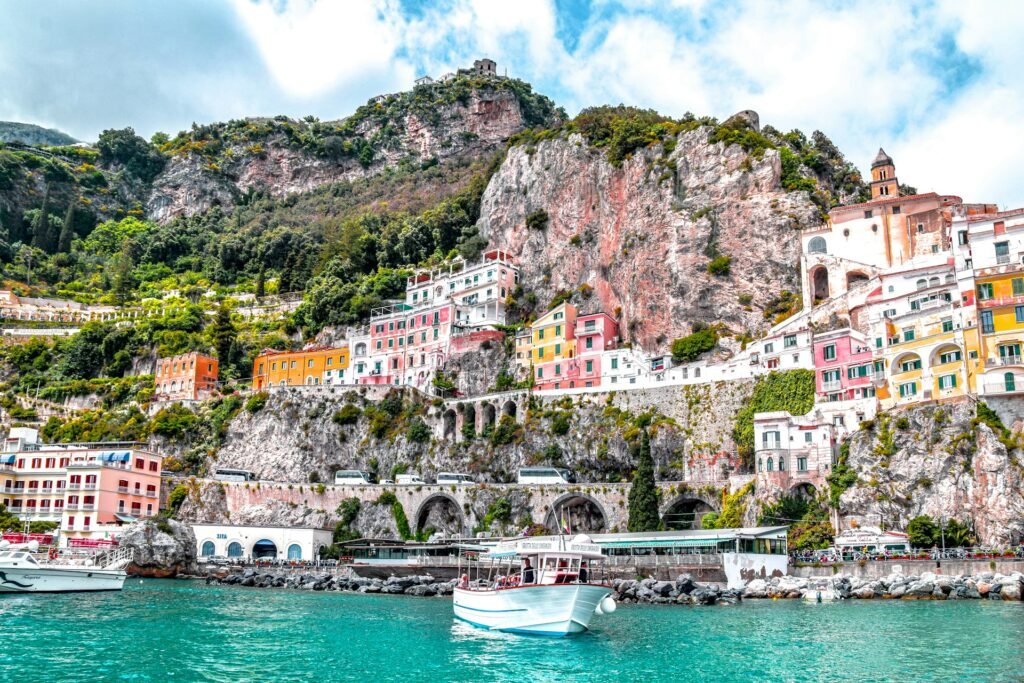This post may contain affiliate links which means we may receive a commission at no cost to you, if you make a purchase through a link. Please see our full disclosure for further information.
The Amalfi Coast, a 50-kilometer stretch along southern Italy’s Tyrrhenian Sea, is a living postcard where cliffs plunge into turquoise waters, and villages cling to slopes like clusters of seashells. It’s no wonder 5 million visitors flock here yearly—each of its 13 towns unfolds a unique chapter of beauty, from west to east.
Starting in the west, Sorrento greets travelers with lemon groves heavy with sun-warmed fruit, their zest infusing local limoncello. Its cliffside promenade offers sweeping views of Capri, and narrow lanes buzz with cafes serving sfogliatella, flaky pastries filled with ricotta.
Next, Positano stuns with candy-colored houses cascading to a pebbly beach, where striped umbrellas dot the shore. Boutiques here sell linen clothes dyed with sea-inspired hues, while boats bob in the harbor, ready to ferry visitors to hidden coves.
Further east, Amalfi Town—the coast’s namesake—boasts a 9th-century cathedral with a golden mosaic facade, its square bustling with vendors selling paper goods (a local craft since the 13th century). Nearby, Ravello perches 365 meters high, its Villa Cimbrone gardens offering “infinity views” of the coast, a favorite spot for weddings and classical concerts.
Tiny Praiano feels like a secret, with its hidden Fjord of Furore, where a stone bridge arches over a emerald inlet. Conca dei Marini wows with the Grotta Azzurra’s electric blue waters, lit by sunlight filtering through underwater caves.
From lively to serene, each town weaves nature and history into a tapestry—cliffs, sea, and centuries of life coexisting in perfect harmony. The Amalfi Coast isn’t just a destination; it’s a feeling: the salt of the sea, the scent of jasmine, and the quiet awe of beauty that feels too vivid to be real.
Exploring the Towns
Positano
Positano is the most famous town on the Amalfi Coast. Its beauty makes it a top destination for travelers.
- History: Positano was once part of the Amalfi Republic. In 1953, John Steinbeck called it “a dream place,” which helped make it famous.
- Things to Do: Visit Spiaggia Grande, the main beach. Shop for handcrafted leather sandals and linen dresses.
- Getting Around: Walking is the best way to see Positano. Be ready for uphill and downhill walks on narrow streets.
- Keep in Mind: Positano can be very crowded during peak season, and it can be expensive.
The Ultimate Guide to Visiting Positano, Italy
Praiano
Praiano is a peaceful alternative to Positano. It’s a small fishing community with local charm.
- Layout: Praiano is split into two areas: Vettica Maggiore and Praiano proper.
- Things to See: Visit the Church of San Gennaro in Vettica Maggiore, known for its beautiful dome.
- Getting Around: Walk, take a bus, or rent a scooter. You can also arrive by boat.
- Good For: People who want a genuine Amalfi experience away from the crowds.
Furore
Furore is a unique village set high above the ocean. It is a quiet and small town. Its secret is a fjord.
- Fiordo di Furore: This narrow inlet has a small beach and blue waters surrounded by cliffs. A bridge crosses the gap above.
- Cliff Diving: Furore is known for cliff diving. It hosts the annual MarMeeting cliff diving championship.
- Access: Reach the beach by a steep staircase or by boat.
Furore – A Gem on the Amalfi Coast
Conca dei Marini
Conca dei Marini is a charming village where you can escape the crowds and relax.
- What to Do: Enjoy the scenery.
- Tower of Silence: Visit this Saracen tower, which was once a cemetery. It has great views.
- Layout: The village has white houses, a small marina, and terraces with lemon groves and olive trees.
- Emerald Grotto: See the Emerald Grotto, a cave with emerald colors reflecting off the rocks.
Amalfi
Amalfi is a busy town with a rich history. It was one of the four major maritime republics of medieval Italy.
- History: Amalfi was known for shipbuilding and navigation. It created the Amalfi Tables, one of the first maritime laws.
- Cathedral of Saint Andrew: Visit this cathedral, which has a mix of architectural styles.
- Streets: Explore the narrow streets, which were designed for pedestrians.
- Things to Know: Amalfi can be crowded and expensive. Shuttle services or ferries are the best way to get around.
A Brief History Of The Amalfi Coast
Atrani
Atrani is a small town near Amalfi. It has avoided the same level of tourist crowds.
- History: Amalfi’s leaders were crowned here in the Middle Ages, at the Church of San Salvatore de Birecto.
- Piazza Umberto I: Visit the town square, which has a fountain, cafes, and locals.
- Beach: The beach is right next to the town square.
- Collegiata di Santa Maria Maddalena: See this 13th-century church with a white and yellow outside.
Ravello
Ravello is a cliffside town high in the Lattari Mountains. It has some of the best views on the Amalfi Coast.
- Atmosphere: Ravello feels open and sophisticated.
- History: Wealthy merchants built villas and palaces here in the Middle Ages.
- Villa Rufolo: Visit this villa with Moorish-inspired architecture and gardens.
- Duomo di Ravello: See this cathedral, which was built in honor of Saint Pantaleone.
Scala
Scala is the oldest town on the Amalfi Coast. It is a quiet and peaceful town.
- Location: Scala sits high in the hills, away from the coastline.
- Things to Do: Scala is best for hikers or people who want to avoid crowds.
5 must-see destinations in Scala – travel amalfi coast
Minori
Minori is a small town between Maiori and Ravello. It is known for its food.
- Beach: Minori has a beach, which is rare for hilltop towns.
- Villa Romana: Visit the remains of a Roman villa.
- Food: Minori is called the “City of Taste.” Try local dishes like scialatielli al limone and handmade pastries.
- Saint Trofimena: Visit the town’s main church, which is dedicated to Saint Trofimena.
Maiori
Maiori is one of the larger towns on the Amalfi Coast. It has a flat area with wide streets and a sandy beach.
- History: A flood destroyed much of Maiori in 1954. The town was rebuilt with a mix of old and new styles.
- Santa Maria a Mare: See this church with a tiled dome.
- Castle of San Nicola de Thoro-Plano: Visit this medieval castle, which overlooks the town.
- Beach: Maiori has the longest beach on the Amalfi Coast.
Erchie
Erchie sits in a small bay between Cetara and Maiori.
- Atmosphere: Erchie is small and intimate. It has a beach that is less crowded and family-friendly.
- Visitors: Mostly Italians visit Erchie.
- Hiking: You can hike to Erchie from Cetara or Maiori.
Cetara
Cetara is a town with a long history of fishing.
- History: The name Cetara comes from the Latin word for “tuna fishing nets.”
- Chiesa di San Pietro Apostolo: Visit the main church.
- Torre di Cetara: See the old medieval tower, which protected against pirate raids.
- Things to Do: Watch the fishermen in the harbor. Enjoy the simple joys of coastal living.
Vietri sul Mare
Vietri sul Mare is the starting point of the Amalfi Coast if you’re coming from Salerno.
- Ceramics: Vietri is known as the “Capital of Ceramics.” Visit stores selling hand-painted tiles and vases.
- Church of San Giovanni Battista: See this church with a green-and-yellow tiled dome.
- Beach: Vietri’s main beach is more functional than attractive.
Ready to Plan Your Trip?
The Amalfi Coast offers something for everyone, from the glamour of Positano to the peacefulness of Atrani. Each of the 13 towns has its own unique charm and history. Which town will you visit first?
Uncover further inspiration in our blog.























